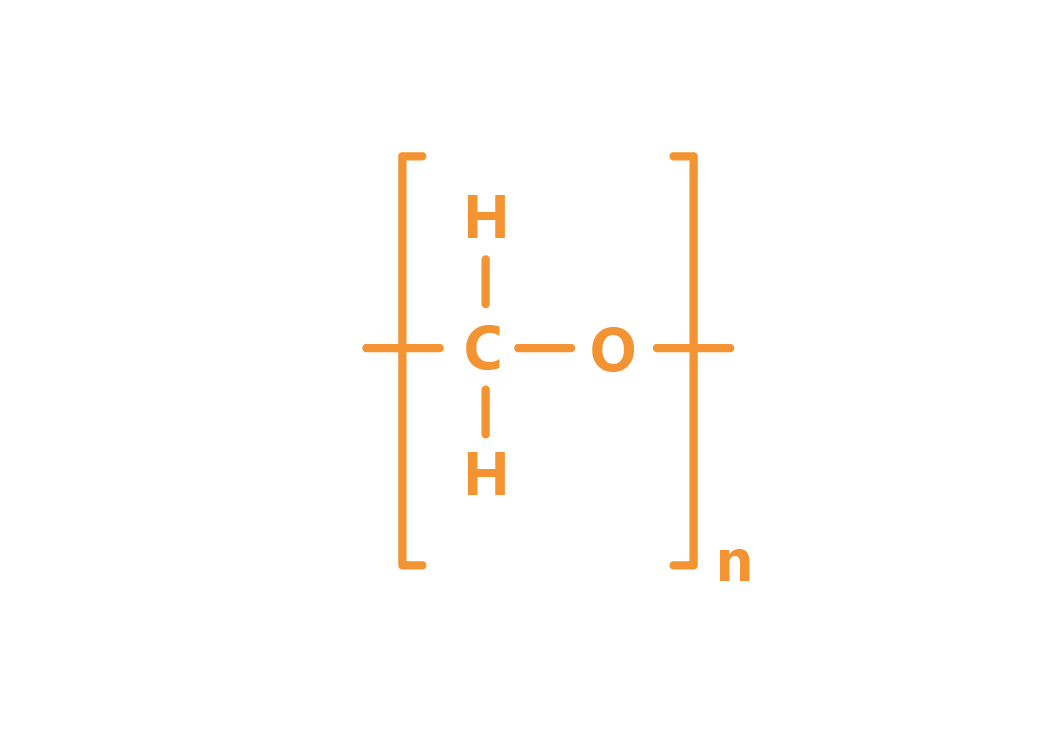
POM
Offers high dimensional stability, hardness and chemical resistance, ideal for automotive and electrical engineering, available as homopolymer and copolymer for specific requirements.

Abbreviation
POM
Molecular formula
(CH₂O)ₙ
CAS no. (POM-C)
24969-26-4
General description
Polyoxymethylene (POM), also known as polyacetal, is a high-performance engineering thermoplastic. It boasts excellent dimensional stability, high hardness, and strength. These properties make POM a preferred choice for technical applications, from the automotive industry to electrical engineering. Despite its semi-crystalline nature, POM remains remarkably chemically resistant and offers excellent sliding and abrasion properties, making it ideal for precision-demanding components.
Chemically, POM exhibits high resistance to many solvents, alkalis, and hydrocarbon-based substances, while being more susceptible to strong exposure to concentrated acids. POM can also be easily modified with additives to meet specific requirements.
POM is available in two main variants: POM homopolymer (POM-H) and POM copolymer (POM-C). POM-H offers higher density, strength, and crystallinity, making it particularly suitable for applications where structural integrity is paramount. In contrast, POM-C scores with better impact strength and chemical resistance, making it more versatile for applications that require greater flexibility and abrasion resistance.
POM offers
High dimensional stability
POM retains its shape and dimensions even under load, making it ideal for precision applications. Its high strength supports its use in load-bearing and mechanically stressed parts.
Chemical resistance
POM resists alkalis, alcohol, and fuels, making it ideal for use in automotive and industrial environments. This resistance extends the service life of components.
Good sliding and abrasion resistance
POM ist perfekt für Anwendungen mit reibungsarmer Bewegung wie Zahnräder und Lager. Diese Eigenschaften verringern Verschleiß und verlängern die Lebensdauer dynamischer Systeme.
Properties of POM
Thermal Properties
POM impresses with its excellent heat resistance, allowing it to be used safely above 100°C. Key differences can be seen between POM homopolymer and POM copolymer. POM homopolymer has a melting temperature of 178°C and a glass transition temperature of -85°C, while POM copolymer has a melting temperature of 166°C and a glass transition temperature of -60°C. POM-C also offers improved long-term stability at higher temperatures, making it even more valuable for specific applications.
Mechanical Properties
POM is known for its exceptional strength and dimensional stability. While the POM homopolymer stands out due to its higher hardness and tensile modulus (2,900-3,400 MPa) and elongation at break of 20-45%, the POM copolymer offers better impact strength, with a tensile modulus of 2,500-3,200 MPa and elongation at break of 15-35%. These specific mechanical properties make both forms of POM ideal for their respective applications.
Chemical Resistance
Chemically, POM exhibits outstanding resistance to alkalis, oils, and aromatics, although it is less resistant to concentrated acids and strongly halogenated solvents. It is particularly resistant to alkaline solutions, oil, and hot water, while it can be more compliant with UV radiation and strongly halogenated solvents.
Other Specific Properties
In terms of specific properties, POM impresses with minimal water absorption, which benefits its high dimensional stability. Its combustion behavior is also noteworthy, as POM self-combusts at an oxygen content of at least 15% in the air. Thanks to its semi-crystalline structure, it is opaque white but can be dyed in various colors. POM can also be painted or metallized for specific applications, further underscoring its versatility.
Processing instructions
Adequate drying is necessary to prevent poor surface finishes on finished parts caused by moisture.
Drying temperature: 120°C – 140°C (max. 120°C for impact-resistant grades)
Drying time: 2 to 4 hours
Residual moisture content: 0.05%
For individual types, temperatures may vary depending on the formulation. Please also refer to the technical data sheets or processing instructions of the raw material manufacturer.
Melt temperature: max. 210 °C, refer to data sheets
Barrel temperature: 170 °C – 200 °C
Mold temperature: 80 °C – 120 °C (impact-resistant types max. 60 °C – 80 °C)
Residence time: min. 3 minutes to max. 10 minutes
Feed temperature: As a rule of thumb, please set 10 °C below the pre-drying temperature of the respective polymer (please consult the injection molding machine manufacturer for the maximum permissible temperatures).
Application areas of POM
Automotive industry: In the automotive industry, POM is often used for gears, fuel system components, and belt guides. Its strength and resistance to oil and gasoline make it ideal for applications that must withstand high mechanical and chemical stress.
Electrical engineering: The electrical engineering industry relies on POM as a material for precision parts in devices such as telephones, radios, and televisions. POM's electrical insulation properties and dimensional accuracy are crucial for producing reliable and durable components.
Medical technology: In medical technology, POM is used for surgical instruments and other medical devices due to its biocompatibility and easy sterilization options. POM's high abrasion resistance and dimensional stability ensure a long service life and safety.
Furniture and construction industry: In the furniture and construction industries, POM is frequently used for fittings, hinges, and door handles. Its ability to withstand various environmental conditions makes it ideal for durable, high-quality components.
Leisure and sports equipment: POM plays a vital role in leisure and sports equipment, as it is used for parts of ski bindings, bicycles, and many other sports equipment that require lightness, strength, and durability.
Its versatility and performance make POM an indispensable material in modern industry. This broad range of applications demonstrates how essential POM has become to our technological infrastructure and underscores its role as a material of choice for technological innovations.

contact
Your partner for POM plastics
Our customers benefit from branded products from leading manufacturers, expert on-site advice, and fast delivery times thanks to warehouse locations in Europe.